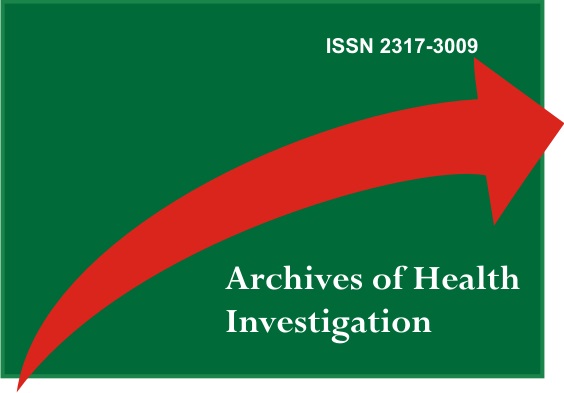Comparison of the erosive potential of original and sour candies
DOI:
https://doi.org/10.21270/archi.v10i9.5248Keywords:
Tooth Erosion, Candies, Saliva, Artificial, Hydrogen-Ion Concentration, AcidityAbstract
Introduction: The frequent consumption of candies is associated with the etiology of dental erosion. Objective: to compare the erosive potential of original and sour candies dissolved in water and artificial saliva. Methods: Original and sour Fini® candies of strawberry, grape, wild fruits and dentures flavors were analyzed, constituting 4 groups: G-1 original candies dissolved in doubly deionized water; G-2- original candies dissolved in artificial saliva; G-3- sour candies dissolved in doubly deionized water; G-4- sour candies dissolved in artificial saliva. The pH of solutions was measured using potentiometer and a combined glass electrode and titratable acidity (TA) by adding 100 μL aliquots of 1M NaOH to solutions until reaching pH 5.5. The calcium concentration was determined using atomic absorption spectrophotometer. Results were submitted to Analysis of Variance (ANOVA). Comparisons of mean pH, TA were performed by the Tukey test at 5% significance level. Results: It was observed that all candies dissolved in water presented pH values below 5.5, with no significant difference between (G-1) and (G-3). When diluting with artificial saliva, the flavors of the G-2 showed pH values significantly higher than G-4 group flavors, that maintained their pH values below 5.5. Regarding titratable acidity in the comparison between G-1 and G-3, it was observed that flavors of the G-3 group showed significantly higher TA. Conclusion: all candies analyzed have erosive potential; however, sour candies showed lower pH, higher TA and lower calcium content, presenting greater erosive potential.
Downloads
References
Lussi A, Carvalho TS. Erosive tooth wear: a multifactorial condition of growing concern and increasing knowledge. Monogr Oral Sci. 2014; 25:1-15.
Ngoc CN, Donovan TE. Education About Dental Erosion in U.S. and Canadian Dental Schools. J Dent Educ. 2018;82(12):1296-304.
Shellis RP, Featherstone JD, Lussi A. Understanding the chemistry of dental erosion. Monogr Oral Sci. 2014;25:163-79.
Buzalaf MAR, Magalhães AC, Rios D. Prevention of erosive tooth wear: targeting nutritional and patient-related risks factors. Br Dent J. 2018;224(5):371-78.
Buzalaf M A R, Hannas A R, Kato M T. Saliva and dental erosion. J. Appl. Oral Sci. 2012; 20(5):493-502.
Hara AT, Zero DT. The potential of saliva in protecting against dental erosion. Monogr Oral Sci. 2014;25:197-205.
Aljawad A, Morgan MZ, Rees JS, Fairchild R. The availability of novelty sweets within high school localities. Br Dent J.2016;220(11):575-79.
Davies R, Hunter L, Loyn T, Rees J. Summary of: sour sweets: a new type of erosive challenge. Br Dent J. 2008;204(2):84-5.
Gambon DL, Brand HS, Veerman ECI. Dental erosion in the 21 st century: What is happening to nutritional habits and lifestyle in our society? Br Dent J. 2012;213(2):55-7.
Aljawad A, Morgan MZ, Fairchild R , Rees JS. Investigation of the erosive potential of sour novelty sweets. Br Dent J. 2017;222(8):613-20.
Brand HS, Gambon DL, Paap A, Bulthuis MS, Veerman ECI, Amerongen, AVN. The erosive potential of lollipops. Int Dent J. 2009;59:358-62.
Feelthan EB. The power of sour candies: a dental hygienist’s battle against dietary dental erosion. CDHA Journal. 2010;25(1):16-8.
Wagoner SN, Marshall TA, Quian F, Wefel JS. In vitro enamel erosion associated with commercially available original and sour candies. J Am Dent Assoc.2009;140(7):906-13.
Correa MSNP, Corrêa FNP, Correa JPNP, Murakami C, Mendes FM. Prevalence and associated factors of dental erosion in children and adolescents of a private dental practice. Int J Paediatric Dent. 2011;21(6):451-58.
Farias MMAG, Silveira EG, Schmitt BHE, Araújo SM, Baier IBA. Prevalência da erosão dental em crianças e adolescentes brasileiros. Rev Salusvita. 2013;32(2):187-98.
Mafla AC, Cerón-Bastidas XA, Munoz-Ceballos ME, Vallejo-Bravo DC, Fajardo-Santacruz MC. Prevalence and Extrinsic Risk Factors for Dental Erosion in Adolescents. J Clin Pediatr Dent. 2017;41(2):102-11.
Salas MM, Nascimento GG, Vargas-Ferreira F, Tarquinio SB, Huysmans MC, Demarco FF. Diet influenced tooth erosion prevalence in children and adolescents: results of a meta-analysis and meta-regression. J Dent. 2015; 43(8):865-75.
Sovik JB, Skudutyte-Rysstad R, Tveit A B, Sandvik L, Mulic A. Sour sweets and acidic beverage consumption are risk indicators for dental erosion. Caries Res. 2015;49(3):243-50.
Oliveira PRR, Amaral FLB, França FMG, Basting RT, Turssi CP. Sour gummy candies and their effect on salivary pH kinetics.PBOCI. 2018;18(1):1-9.
Lussi A, Schlueter N, Rakhmatullina E, Ganss C. Dental erosion-An overview with emphasis on chemical and hispopatholigicol aspects. Caries Res. 2011;45(Suppl 1):2-12.
Bonvini B, Soares AK, Farias MMAG, Araújo S, Schmitt BHE. Mensuração do potencial erosivo de balas dissolvidas em água e saliva artificial. Rev Odontol. 2016;45(3):154-58.
Farias MMAG, Lazzaris M, Schmitt BHE, Silveira EG, Araújo SM. Erosive potential of sugar-free hard candies dissolved in water and artificial saliva. Braz J Oral Sci.2016;15(1):75-8.
Lazzaris M, Farias MMAG, Araújo SM, Schmitt BHE, Silveira EG. Erosive potential of commercially available candies. PBOCI. 2015; 15(1):7-12.
Farias MMAG, Soares AK, Bonvini B, Araújo SM, Schmitt BHE. Potencial erosivo de doces azedos (sour candies) dissolvidos em água e saliva artificial. RFO-UPF. 2017;22(2):177-81.
Barbuor ME, Lussi A. Erosion in relation to nutrition and the environment. Monogr Oral Sci. 2014;25:143-54.
Shellis RP, Barbour ME, Jesani A, Lussi A. Effects of buffering properties and undissociated acid concentration on dissolution of dental enamel in relation to pH and acid type. Caries Res. 2013;47(6):601-11.


